
BOSTON'S HISTORY BEGINS
AT THE STATUE OF JOHN WINTHROP
IN FRONT OF THE PRESENT FIRST CHURCH BOSTON
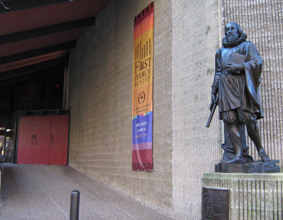
1) Start in front of First Church Boston, at the statue of Governor John Winthrop, ‘America’s Forgotten Founding Father.’ He is in formal Puritan dress, with full cape, a stiff ruff (‘piccadilly’) collar, lace shirt & ribboned shoe buckles. He holds the newly translated King James (Authorized Version) of the Bible next to his heart, with the Charter of the Massachusetts Bay Company in his right hand. This is the only English Colonial Charter brought into the New World. By this action the stockholders were enabled to develop independent religious practices & civil governing procedures in church & town.
Winthrop’s expression suggests: ‘We shall be as a city upon a Hill. The eyes of the world are upon us.’
Sculptor Richard S Greenough’s original marble sculpture (1873) is in the National Statuary Hall in the Capitol Building, Washington, DC.
At the corner of Berkeley Street, turn right. The local ‘puddingstone’ tower, steeple and facade of the original, 1868 Ware & van Brunt building serve as the East walls for the new edifice by Paul Rudolph, dedicated in 1972. The charred wood frame of the ‘rose window’ opening serves as a reminder of the all-consuming, 1968 fire.
Continue to the Commonwealth Avenue Mall, Boston’s Champs Élysées. (Elysian Fields.) Note also the Parisian Mansard Roofs. Turn left to walk through the Public Garden, laid out in 1860, with its flower plots & Swan Boats, to Charles Street, (formerly the banks of the Charles River).
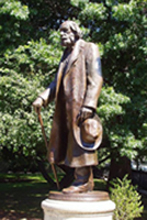
2) At the end of the path, on the left, the Bela Pratt sculpture is of Edward Everett Hale, third minister of South Congregational Church, formed in 1827. Author of The Man without a Country, reformer & founder of the Lend-a-Hand Society, in retirement Rev. Hale became Chaplain of the United States Senate. (Hale’s Church was located at the corner of Newbury and Exeter Streets.
It merged with First Church Boston in 1925, after the ministry of Edward Cummings.)

3) Carefully, cross Charles Street to the historic Boston Common, the nation’s oldest city park. (1634) Now walk up hill & diagonally left to the Founders’ Memorial. In the allegory, Shawmut Peninsula resident William Blackstone welcomes John Winthrop & First Church Boston Pastor JohnWilson. Next is Ann Pollard, the first white woman to set foot on Shawmut land. The Arbella, the company’s flagship, lies at anchor in Mass Bay. On the far right is a figure symbolizing the “Motherhood of Boston”, protected by a Puritan soldier. Native Americans join in the welcome. Blackstone’s house and spring were located just here, at the foot of Beacon Hill. The monument was erected in 1930 for the Tercentenary of Boston: Michael Curley, Mayor; John Paramino, artist.
![]()
4) Walk further up the Hill to the gate at Joy Street. Cross to
‘25 Beacon,' International Headquarters of the Unitarian Universalist Association.
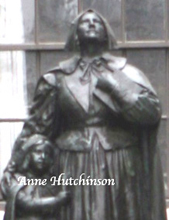 On the State House grounds next door is Cyrus Dallin’s statue of Anne Hutchinson with one of her fourteen living children. Mrs. Hutchinson with her family had followed her minister, John Cotton, from Boston, Lincolnshire, England to the New World in 1633 because of Cotton’s emphasis on the Doctrine of Grace. Anne’s personal interpretation of this spiritual force ran counter to the Bay Colony ministers who preached a Doctrine of Works.
On the State House grounds next door is Cyrus Dallin’s statue of Anne Hutchinson with one of her fourteen living children. Mrs. Hutchinson with her family had followed her minister, John Cotton, from Boston, Lincolnshire, England to the New World in 1633 because of Cotton’s emphasis on the Doctrine of Grace. Anne’s personal interpretation of this spiritual force ran counter to the Bay Colony ministers who preached a Doctrine of Works.
In her trials, Anne was thought to be well versed in Scripture, but her strong beliefs caused her to be ‘cast out of the Church’ & banished from Boston by its Ministers. Many First Church Boston members remained her friend & moved with her to Rhode Island. The statue was given to the State by the Anne Hutchinson Memorial Association & Massachusetts State Federation of Women’s Clubs, & placed on the Capitol lawn in 1922.
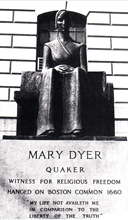
5) Further along Beacon Street is the statue of Mary Dyer, Quaker, a friend & companion of Hutchinson. Later, in her desire to aid Quakers imprisoned in Boston, Mary made continuing trips to Boston. Warned that she faced death if she continued these forays, (even though she was repeatedly reprieved by Mass Bay Colony Magistrates), on her visit in 1660, she was made a martyr by hanging on the Common. (Quakers unsettled Puritans by not taking Jesus seriously enough, by disrupting Puritan services, & by parading through Boston unclothed.)
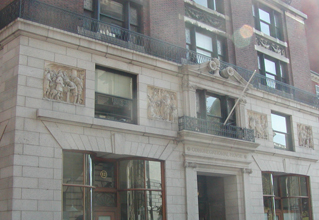
6) At 14 Beacon Street is the outstanding repository of church materials, the Congregational House & Library, (1895). New England Puritans (Nonconformists - First Church) & Pilgrims (Separatists - Plymouth) were all individually covenanted congregations, governing themselves by ‘congregational polity.’ After the Revolutionary War, congregational churches divided again, as Unitarian (‘One God’) & Congregational (Trinitarian). The Congregational Denomination is presently known as the United Church of Christ (1957).
An interpretation of the bas reliefs on the second floor may suggest scenes of the early Bay Colony religious activity:

The first services were held
under the “umbrage of an ancient oak.”
Here baptisms were conducted at the
Shawmut Peninsula’s fresh springs.
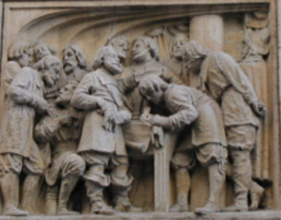
First Church Boston Colonists
sign the Church Covenant,
July 30, 1630, making this
Church the oldest organized
religious institution in Boston.

Sir Henry Vane, Governor,
proposes to the Court of Assistants
the creation of a school to
educate ministers, Harvard College.
Governor Winthrop has his back to us.
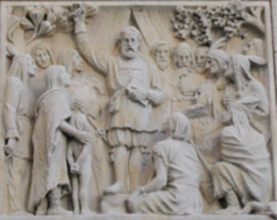
John Eliot preaches to Native Americans.
(The Spanish artist of these bas reliefs was Domingo Mora.)
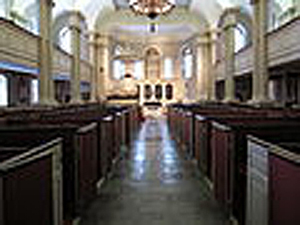
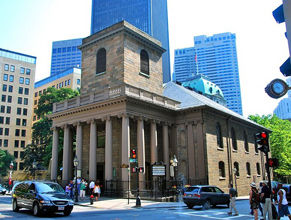 7) Continue down Beacon to Tremont (Tri-mountaine) Street. Across is King’s Chapel (now Unitarian). Until the Massachusetts Bay Charter was returned to London in 1686, & a Royal Governor, Sir Edmund Andros, was sent to preside over the Dominion of New England, Church of England clergy had not been allowed into the Colony. A small wooden structure was built on this site in 1688 to serve British Officers. The present building (1749) is by Peter Harrison, in American Georgian style. Next to the Chapel is ‘The Old Burying Ground’ where the remains of several First Church Boston ministers lie: John Cotton, John Davenport, John Norton, William Emerson, and, most recently, Rhys Williams (2003).
7) Continue down Beacon to Tremont (Tri-mountaine) Street. Across is King’s Chapel (now Unitarian). Until the Massachusetts Bay Charter was returned to London in 1686, & a Royal Governor, Sir Edmund Andros, was sent to preside over the Dominion of New England, Church of England clergy had not been allowed into the Colony. A small wooden structure was built on this site in 1688 to serve British Officers. The present building (1749) is by Peter Harrison, in American Georgian style. Next to the Chapel is ‘The Old Burying Ground’ where the remains of several First Church Boston ministers lie: John Cotton, John Davenport, John Norton, William Emerson, and, most recently, Rhys Williams (2003).
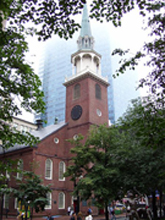
8) Walk down School to Washington Street. There, The Old Corner Book Store stands on the Hutchinsons’ lot. John Winthrop’s land was across the street, next to Rev. John Norton’s plot. After Norton’s death, his widow, Mary Norton gave this land to 40 disaffected members of First Church Boston, who, in 1669, covenanted to become the Third (‘Old South’) Church in Boston. The present building - Old South Meeting House (1729), is by Joshua Blanchard.
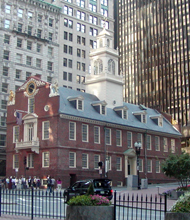
9) Turn left on Washington Street to the Old State House. At the head of State Street, on your left, First Church Boston’s building - Old Brick - stood, occupying the lot on which the Mellon Building, One Boston Place, rises.
An earlier (1640) First Church Boston building had been of wood & burned down, along with the then Town House, in the great fire of 1711. Church records read: “One Mary Morse [a Church member] being in drink” caused a good portion of Boston to be turned into ashes. The site of ‘old’ First Church Boston (1632), is marked by a granite lintel over the door of 25 State Street. John Winthrop (Governor), John Wilson, John Eliot & John Cotton, First Church Boston Ministers, are listed.
10) Go past the Old State House to Boston City Hall. Turn right down the stairs and cross Congress Street to the Faneuil Hall side. Turn left, going by the New England Holocaust Memorial (Stanley Saitowitz, artist, 1995), to Haymarket Street.
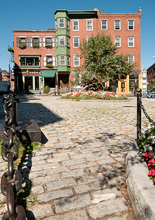
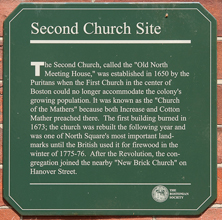 Cross over to the 'North End.' Take Hanover Street for one block, then turn right on Prince Street to Old North Square. The original Second (‘Old North’) Church was dedicated in 1650, & stood on the high point of the square diagonally across from Paul Revere’s House.
Cross over to the 'North End.' Take Hanover Street for one block, then turn right on Prince Street to Old North Square. The original Second (‘Old North’) Church was dedicated in 1650, & stood on the high point of the square diagonally across from Paul Revere’s House.
When the Second Church building was torn down by the British ‘for firewood’ during the winter of 1775/6, the members took refuge in the Seventh (‘New Brick’) Church on Hanover Street where Paul Revere & his wife Rachel were lifelong members. Seventh Church voted to become Second (‘Old North’) Church on the death of its Minister, Ebenezer Pemberton, in 1779.
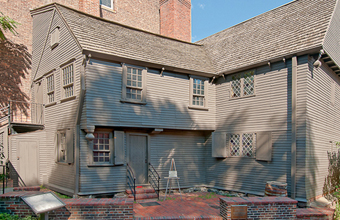
From the rear exit of Paul Revere’s house, he could step out from this door, and go directly across his garden to the entrance of Second Church on Hanover Street (formerly Seventh Church) where he was a member, and take his pew in the first row.
Link to PDF to print out
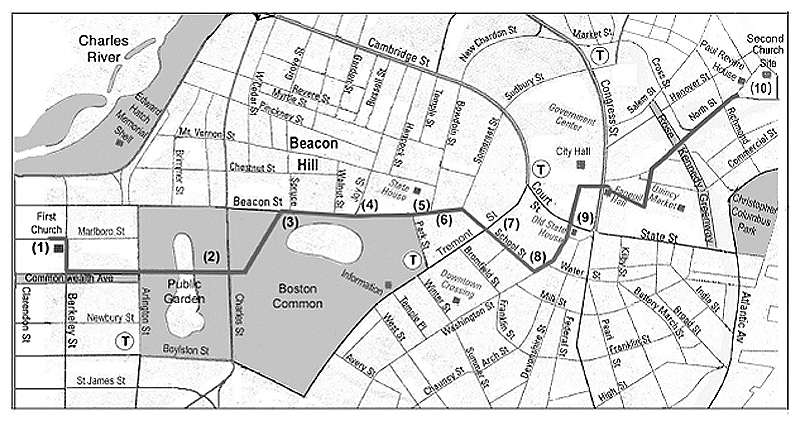
The "Front Yard" of
Boston's First Church